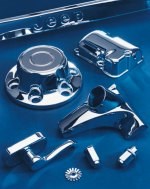Chromium Plating Replacement
New barrel plating process can replace chromium plating at half the cost...
From the company's beginnings as a small job shop in 1959, to its current position as a leader in the metal plating industry, integrity, quality and service have always been the driving force behind Master Finish Co., Grand Rapids, Michigan.
Today, Master Finish continues to provide high-quality workmanship by investing in the latest plating technologies. The company is commit-ted to providing 100-pct customer satisfaction.
Featured Content
One new technology is a barrel plating process that can replace chromium plating at half the cost, according to Dale Mulder, company president. The new plating technology allows an alloy with a bright chromium-like color to be deposited using barrel plating. Until this technology was available, small steel and brass components that required a bright decorative finish had to be processed on Master Finish's rack plating lines.
Key blanks, small hardware components such as drawer pulls, and small hand tools such as sockets are just a few of the products that are good candidates for this process. According to Mr. Mulder, "This is not just a new twist on existing technology, but actually a significant advance." He says that his company has saved customers nearly 50 pct off the cost of the usual rack plating process.
| TABLE I — Enloy Ni-150 Salt Spray Test Results | ||||
| Steel Panel, 0.2 mil nickel | ||||

|
Hexavalent Chromium | EnloyTM Ni-150; no passivate | Enloy Ni-150; with passivate | Trivalent Chromium |
| 8 hours | No Corrosion | Blue Tarnish | No Corrosion | 10 pct Rust |
| 24 hours | No Corrosion | Blue Tarnish | No Corrosion | 40 pct Rust |
| 48 hours | 2 pct Rust | 
|
No Corrosion | 80 pct Rust |
| 96 hours | 50 pct Rust | 
|
No Corrosion | 
|
| 120 hours | 
|
1 pct Rust | No Corrosion | 
|
| 550 hours | 
|

|
1 pct Rust | 
|
The barrel process is effective for three reasons: 1) Parts can be plated in large quantities, reducing labor costs; 2) Specially designed racks are not required; and 3) Waste treatment is simplified, because chromium is eliminated.
Although most electroplated metals can be deposited using either rack or barrel processes, chromium will not deposit properly without continuous electrical contact with the workpiece. The slurry action of parts rotating in a barrel does not allow the electrical contact that decorative chromium electroplating requires.
| TABLE II — Enloy Ni-150 Operating Conditions | |
| Temperature | 140F |
| pH | 6.3 |
| Cathode current density | 20 asf |
| Anode current density | 10 asf |
| Voltage | 2 to 15 volts |
| Time | 8 min |
| Surface tension | 52dynes/cm |
A research team at Enthone-OMI Inc., developed a proprietary nickel alloy plating process that provides the appearance of bright chromium plated deposits. Master Finish Co. plates a nickel strike followed by the Enloy® Ni-150 electroplate onto steel and brass components. Although components with class "A" surface requirements are not good candidates for barrel plating, most other components can be processed with this method.
The process produces a metallic alloy electroplated coating for use over nickel-plated substrates. When used in conjunction with the proprietary passivate, the deposit yields a chromium-like finish with excellent corrosion resistance (Table I). Bath operating conditions are outlined in Table II.
The plating process demands detailed care and meticulous testing. Master Finish uses state-of-the-art plating facilities and highly skilled master technicians. The company adheres to advanced statistical process controls, including compliance with ISO/QS 9000 standards. These rigorous quality standards, along with its in-house laboratory guarantee high-quality finishes.
The company statistically monitors raw materials consistency. Plating bath solutions are also continually monitored. Testing procedures and controls include x-ray fluorescence coating measurement; microscopic metallographic examination; CASS corrosion testing; Kocour plating thickness analysis and step testing; statistical plating bath monitoring; monitoring of raw material consistency and finished product quality.
The company has always strongly believed in responsible waste control. All the company's environmental standards exceed those of local, state and federal regulations.
The waste control system complies with ISO 14001 standards and includes treatment of hazardous solutions, as well as environmentally safe recycling. Residues become raw material for smelting stainless steel. This process keeps all heavy metal by-products out of landfills and streams.
RELATED CONTENT
-
Zinc Electroplating
Choosing the best process for your operation.
-
Blackening of Ferrous Metals
The reasons for installing an in-house cold blackening system are many and varied.
-
A Chromium Plating Overview
An overview of decorative and hard chromium electroplating processes.




















